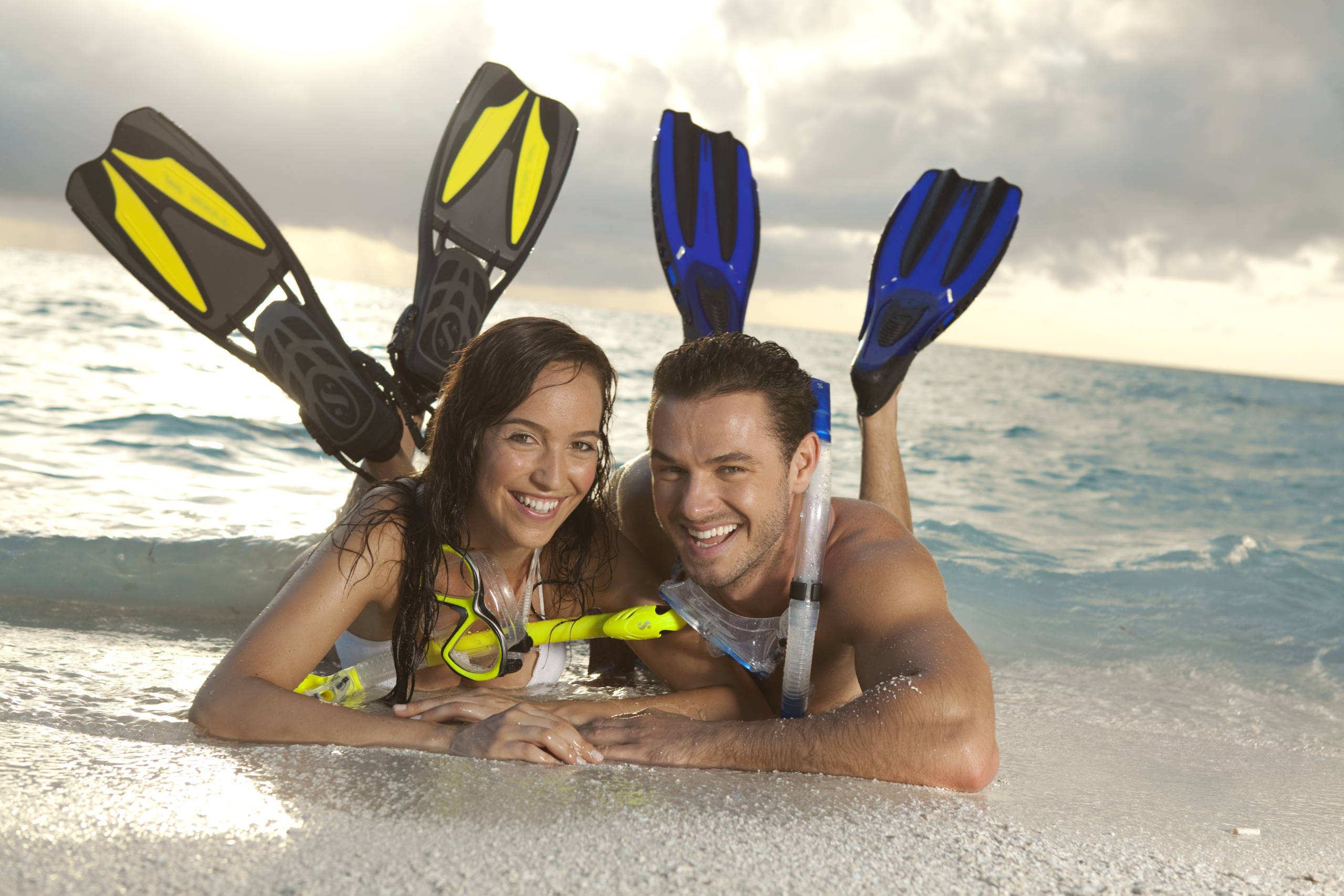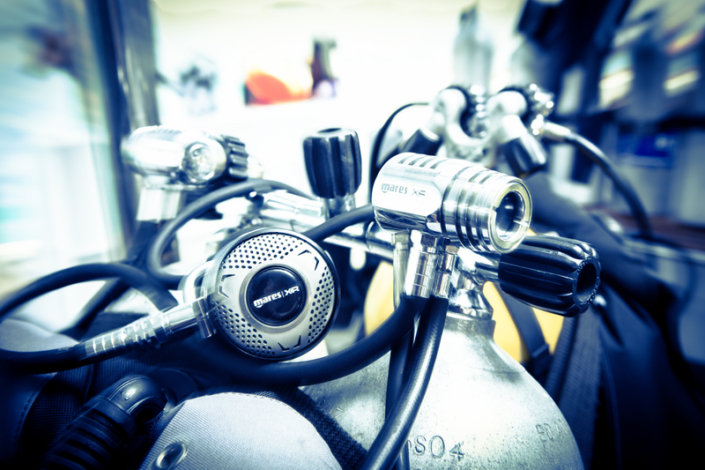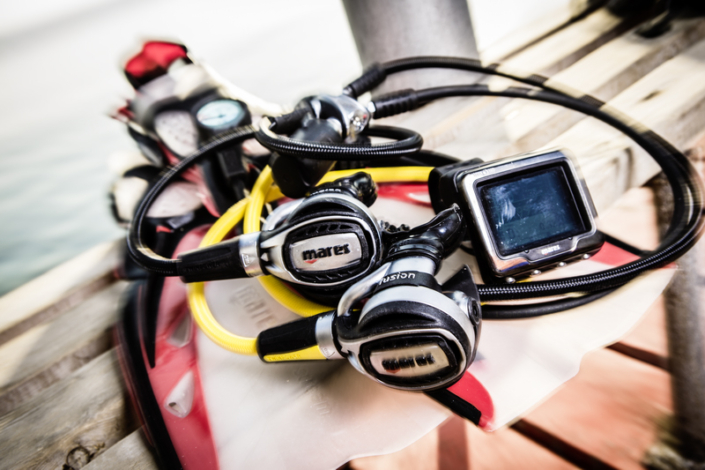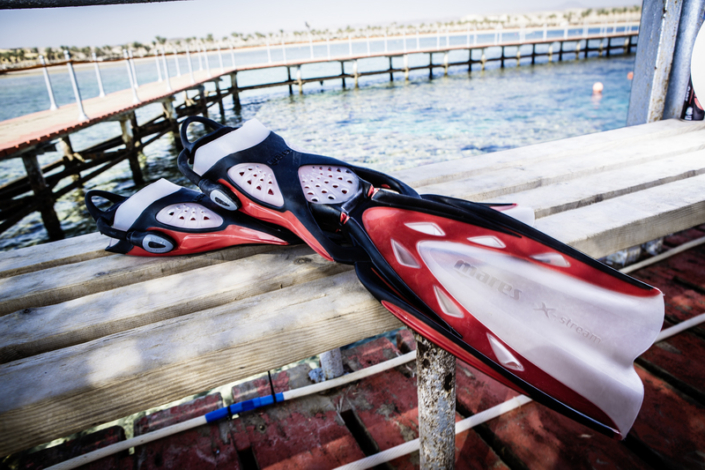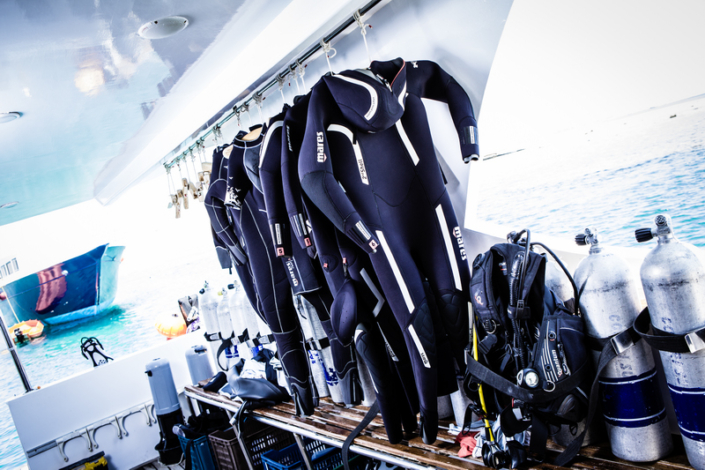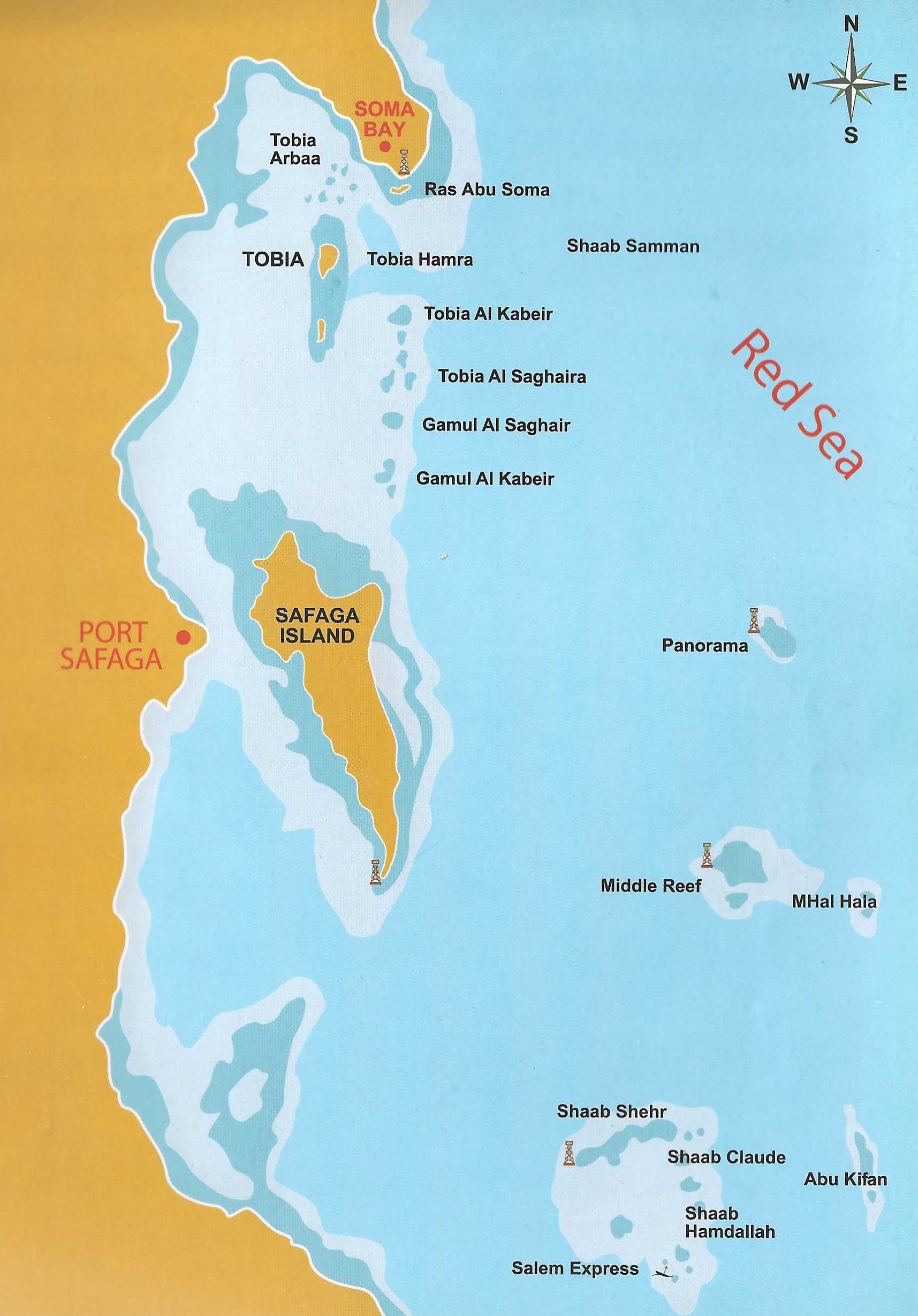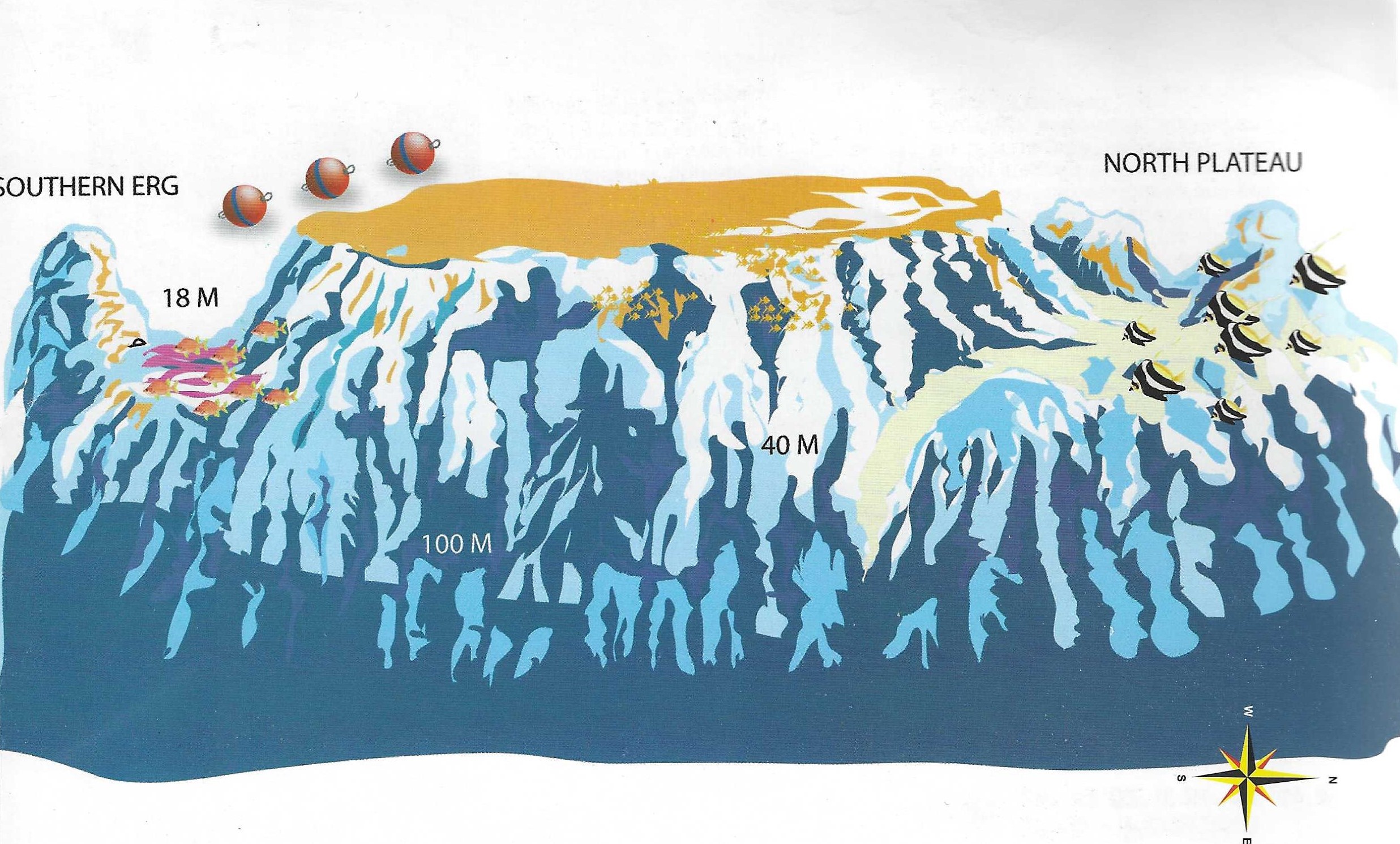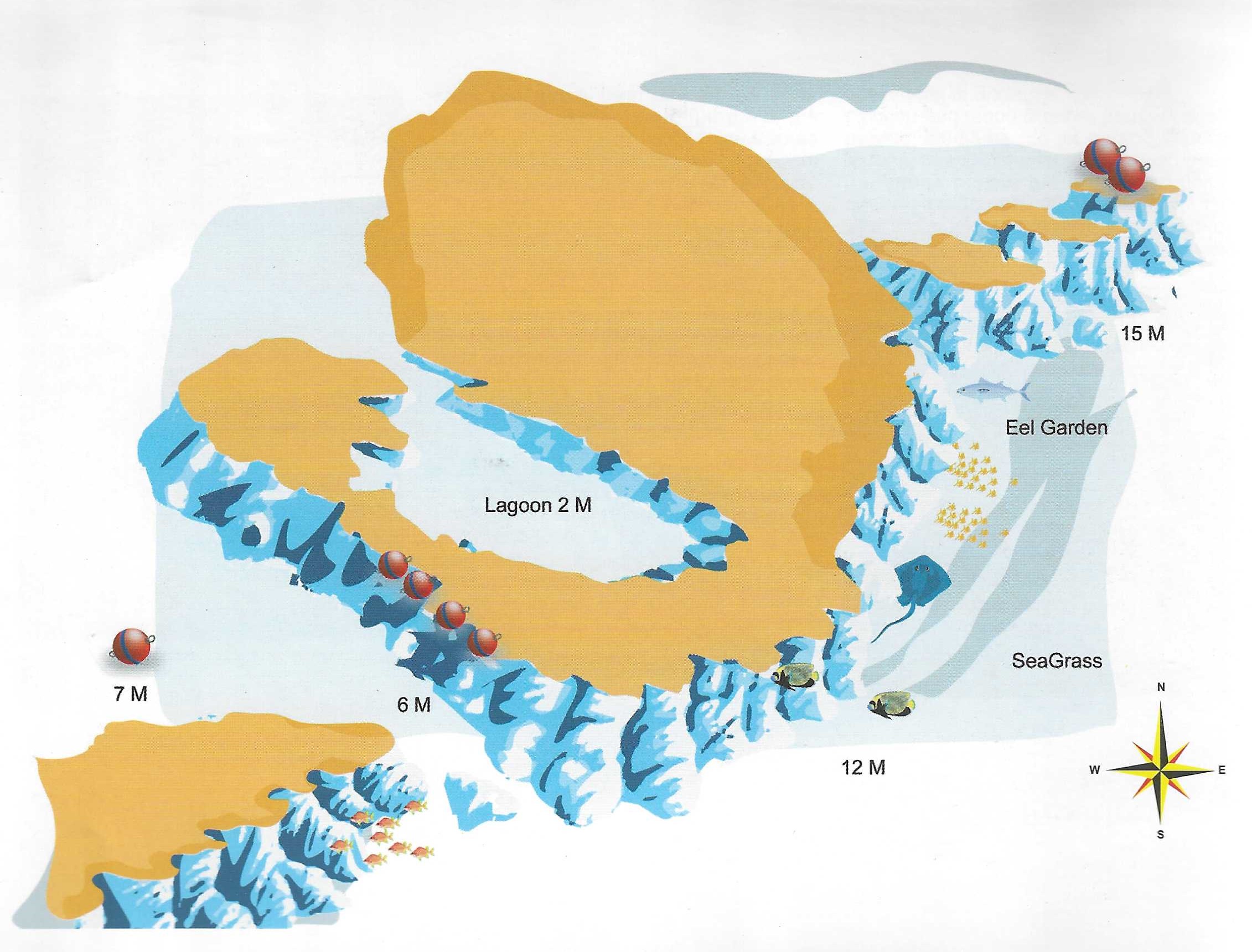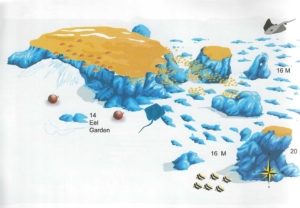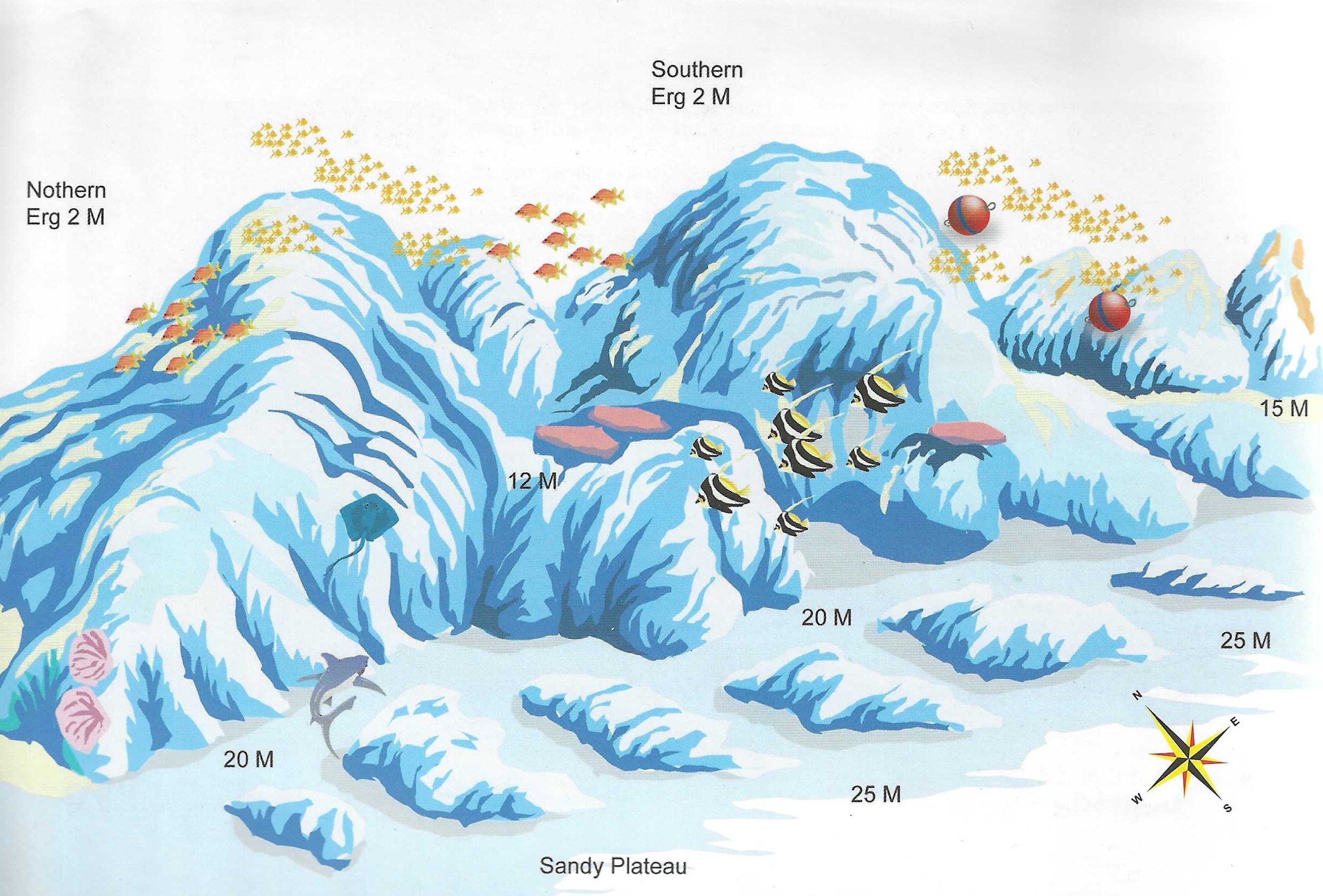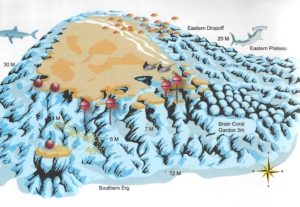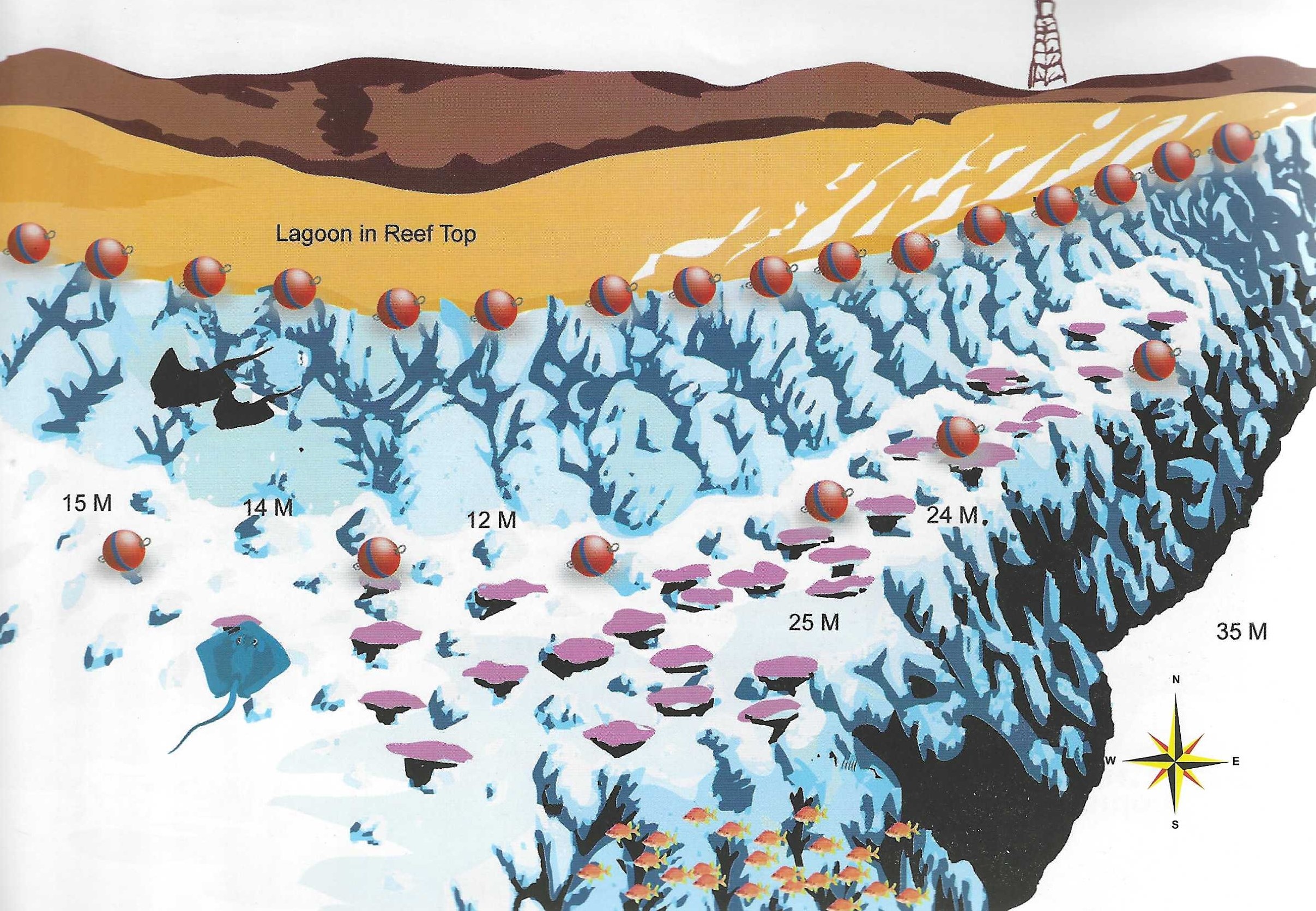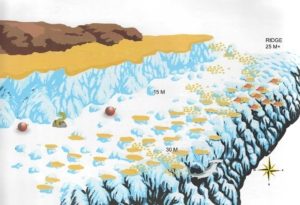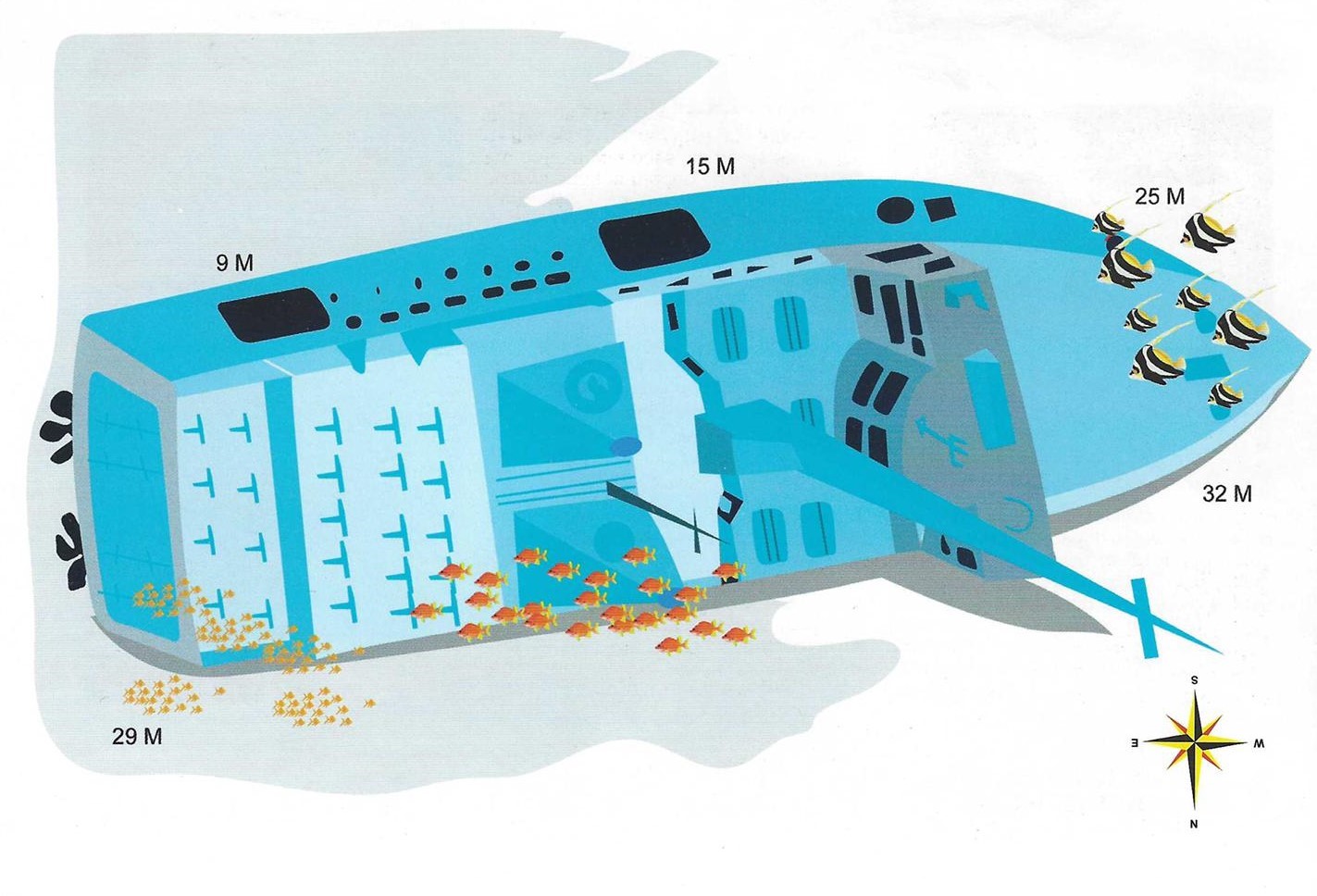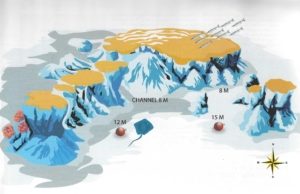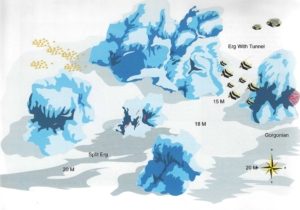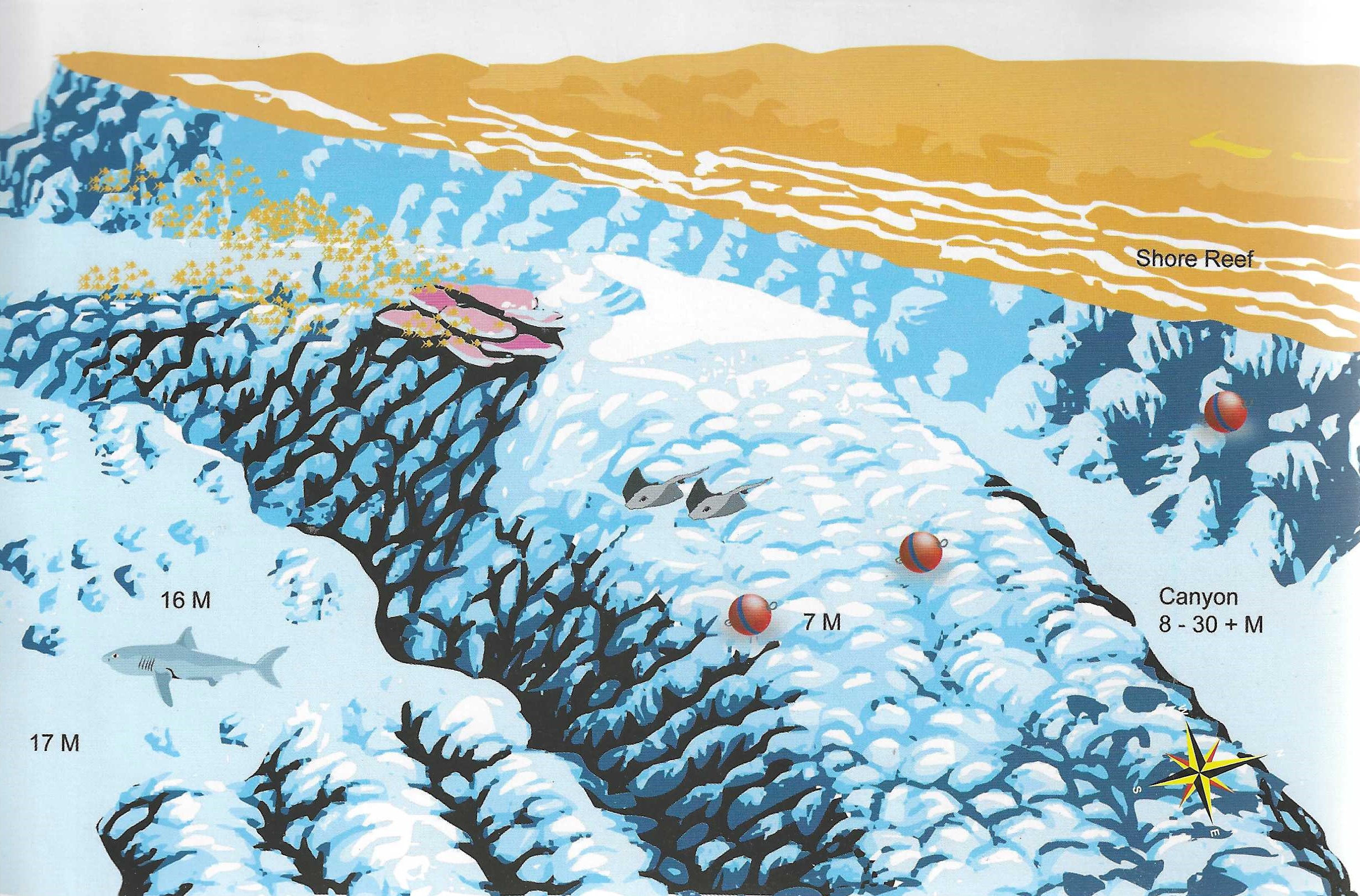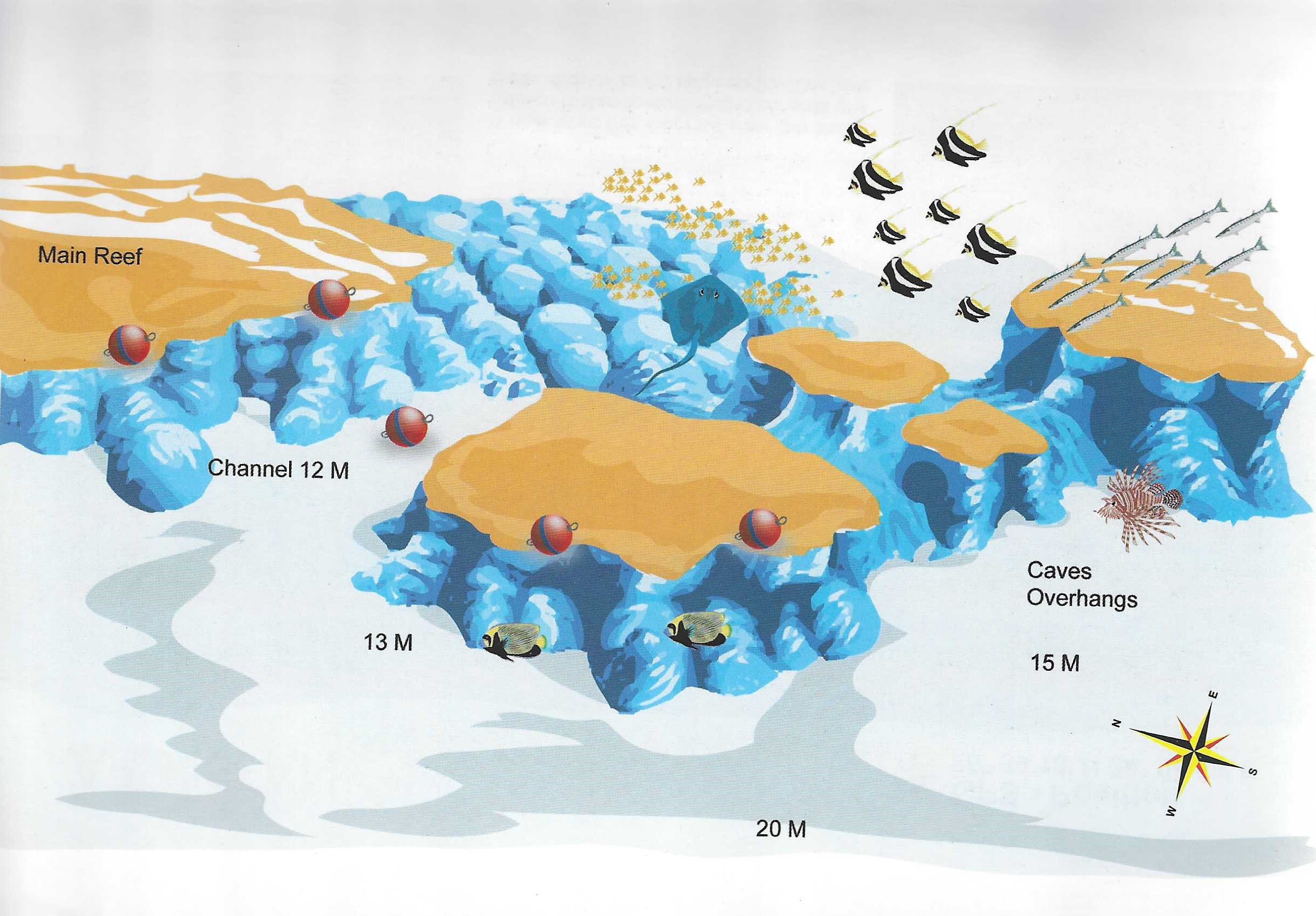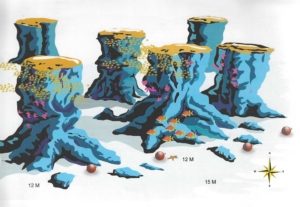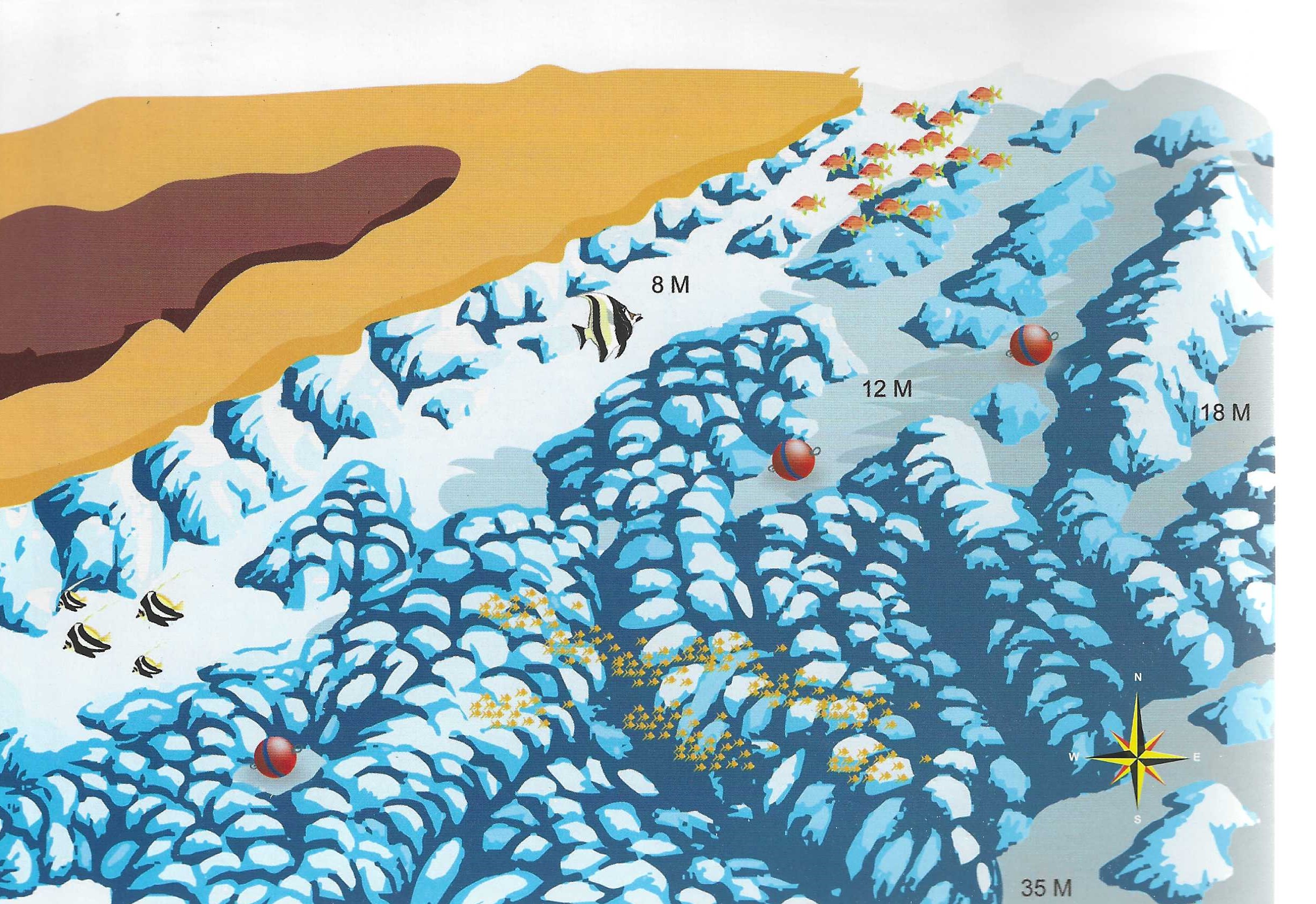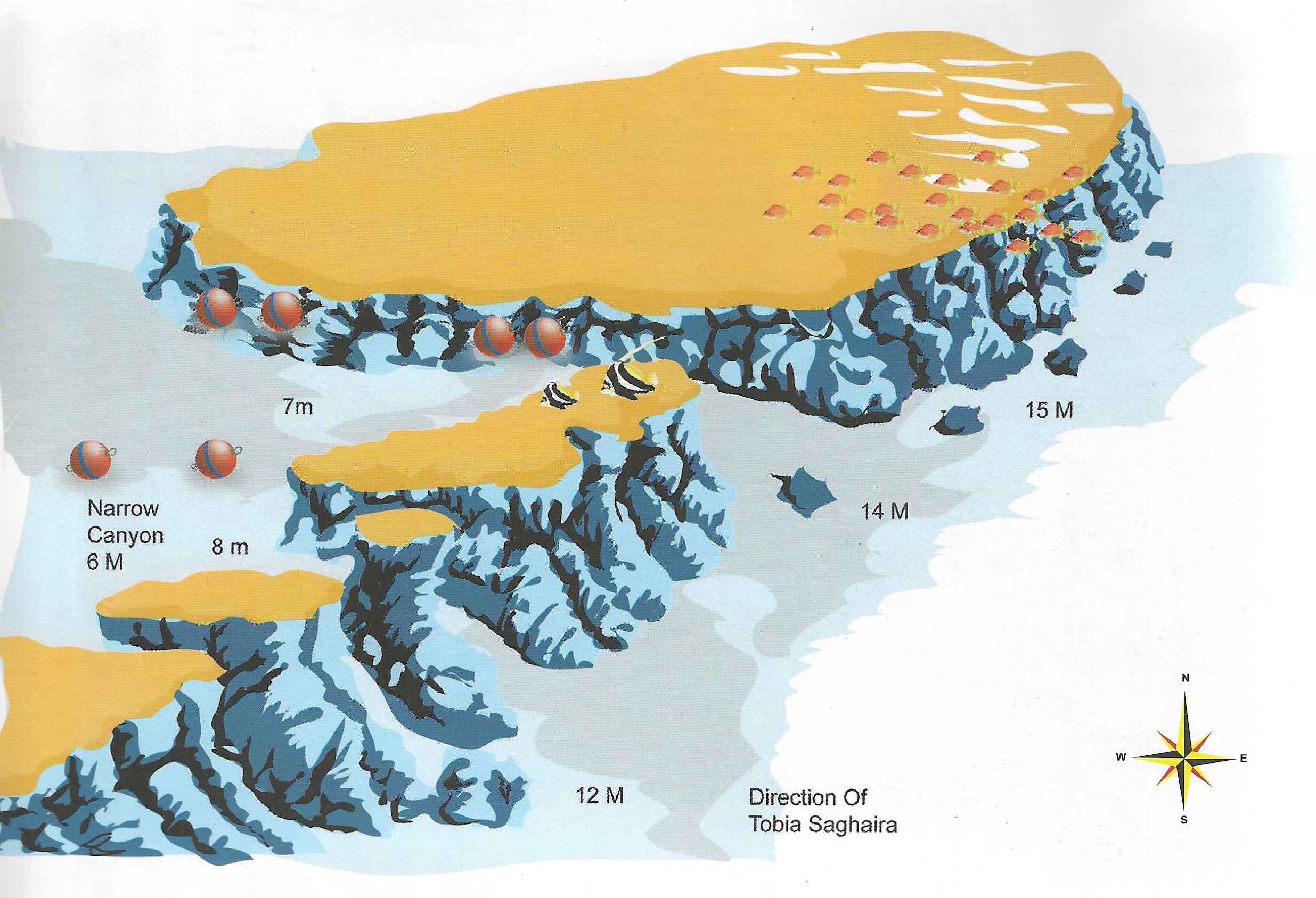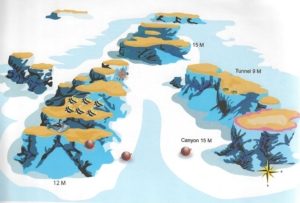SAFAGA DIVE SITES
ABU KIFAN
DESCRIPTION
ABU KIFAN
- Location – Abu Kifan is a long thin strip of reef 90 minutes to 2 hours outside Safaga. Its name roughly translated mean ‘The Deep One. “When you dive it, you will see why. Its walls plunge vertically from the surface past the 100m mark. To the north, a plateau stretches seawards with two prominent coral blocks down the middle. At the south is a large and colourful erg which joins the main reef at approximately 18m. Beyond it the reef stretches interminably southwards at 30m.
- Sea Conditions – Like all the outer reefs at Safaga the journey out can be a little lumpy, but once you arrive the boat is well protected. The current comes from the northwest and runs at anything from mild to pumping.
- Dive Plan – If you get the chance drift dive the north plateau and east wall. Most locals race it even higher than Panorama north plateau (beware of an east to west cross-current). If the weather prevents that then it’s still worth getting wet for the south end of the reef. Dive from the moorings, past the southern erg and, if current allows, up the east wall and then back.
- Marine Life – The walls are smothered with soft corals, black corals and gorgonians. Turtles are common and grey reefs and silvertips are occasionally seen. On the north plateau, look out for big tuna (1-1.5m long). There are several large barracuda resident and, at certain times of year, schools in the hundreds appear. Hammerheads cruise by in late summer. Strangest of all is a school of glasseyes numbering over one hundred. They hover over the plateau, unlike most anywhere else (they are usually solitary), and if a big predator happens by they rush to the wall for protection.
DIVE TYPE
WALL/DROP OFF
DRIFT DIVING
LEVEL
ADVANCED
EXPERT
MAX. DEPTHT
26 METER
GAMUL AL KABEIR
DESCRIPTION
GAMUL AL KABEIR
- Location – Just north of Shadwan Island and about 20 minutes from Safaga is a large round reef known as Gamul al Kebeir. At its centre is a perfect, circular lagoon. To the south is a long nondescript reef and to the northeast are three small and colourful ergs. All around are sea grass beds.
- Sea Conditions – It is accessible in any weather and the moorings are very sheltered. Current comes from the northeast and can occasionally run quite strong.
- Dive Plan – Either leave the boat at the moorings and head out through the “fossma” in the direction of the three ergs (it takes 20-30 minutes depending on current), or enter the water in the region of the three ergs. Your boat can then head down to the moorings where you can reach it later.
- Marine Life -This reef is known for a mean-looking school (15-20) of big barracuda 1.5m+. They are a mixture of chevron and pickhandle barracuda and operate in the region of the three ergs or over the seagrass beds to the north of the main reef. Eagle rays are also commonly seen here as are whitetips and also, though more rarely, sea cows. Around the ergs are unicornfish, snappers, bigeye emperors, bream and scrolled filefish. In the sand live a colony of garden eels and if you look closely, pegasus or sea moths may also be found.
DIVE TYPE
WALL/DROP OFF
LEVEL
BEGINNER
MAX. DEPTHT
METER
GAMUL AL SAGHIR
DESCRIPTION
GAMUL AL SAGHIR
- Location – Less than 15 minutes outside Safaga lies Gamul al Saghir. It is the second in a chain of reefs stretching northwards from Safaga Island. It is round in shape with four outlying ergs to the southeast. Only two can be seen from the Surface.
- Sea Conditions – You can reach Gamul al Saghir in any weather. In fact, when it’s too rough to get to the outer reefs, it is your best chance of aquality dive. The current comes from the north, splits and runs down either side of the reef.
- Dive Plan – Head straight to the ergs on the southeast side of the reef, taking in the eel garden en route. The large erg nearest the main reef reaches the surface from 13m, outside it, in 16m of water, is a hollow pillar 6-7m high with agorgonian inside. About 60m south of here is a very picturesque horseshoe shaped erg and 70m south of that is the best erg of all. It reaches the surface, standing in 18m water and is overhung on the south side with glassfish, hatchetfish, cardinalfish and silversides in abundance, along with their normal predators. Having completed the ergs, check your air. If you have over 100 bar, you may circle the main reef. If you have less, then work your way slowly back to the boat.
- Marine Life – On the ergs, schools of bream, batfish, bigeye emperors, sweetlips, bannerfish, fusiliers, red snapper and black snapper. Hunting the glassfish – redmouth grouper and lionfish. On the main reef , squirrelfish, soldierfish, glasseyes and cardinalfish in the many crevices. Sweetlips schooling alongside snowflake groupers and lunartail groupers and bluespotted rays everywhere.
- Rarities – There is a green anemone on the hollow coral pillar whilst on the main reef a frogfish is resident (position undisclosed) and in ’97 a sea cow made this her home for a while.
DIVE TYPE
WALL/DROP OFF
LEVEL
BEGINNER
MAX. DEPTHT
METER
HAL HAL
DESCRIPTION
HAL HAL
- Location – Hal-Hal is a fisherman’s expression meaning restless sea and it’s true, the sea is almost constantly choppy here. Two ergs push up from the edge of a plateau to about 3m short of the surface and offer no protection. They lie about 400m southeast of Middle Reef. On the inside (west), the plateau has 16m depth, whilst on the outside it drops to a wide ledge at 22-24m. This ledge has a drop-off about 80m cast which is vertical, if not overhanging and starts at 30m. Hal-Hal is also known as Shaah Kweiss (meaning “Nice Reef”) but then so is any reef in The Red Sea that your skipper has forgotten the name of.
- Sea Conditions – You’ll need exceptional conditions to reach Hal-Hal and even then, nine times out of ten, the current will be too strong to even get in the water.
- Dive Plan – If you’re lucky enough to make a dive here, you’ll find the most vibrant, colourful, lively reef you’ve ever seen. The fish don’t sleep here, they constantly’ twist and turn in a game of eat or be eaten. The site is so compact you can circle it 2-3 times at ascending depths, but don’t go with a plan – the current will make your mind up for you. Visit the drop-off to look for pelagics, but only if you’re very good on air and have a strong sense of direction.
- Marine Life – The reef is a blaze of soft corals and gorgonians, with a sizeable table or two. As far as fish life goes, you’ll see the normal stuff but tons of it. Leopard groupers, turtles. goatfish, scrolled filelish, unicorns, longnose unicorns and whitetip sharks to name a few. On the top of the ergs, red-mouth groupers line up to snatch at the clouds of anthias instead of their normal prey, glassfish. A school of bannerfish hugs close to the reef for protection. On the drop-off, you’ll see snapper schools, surgeonfish schools, schools of small tuna, large solitary tuna and, at certain times of year, a school of Spanish mackerel that stretches as far as the eye can see.
DIVE TYPE
WALL/DROP OFF
LEVEL
BEGINNER
MAX. DEPTHT
METER
MIDDLE REEF
DESCRIPTION
MIDDLE REEF
- Location – 90 minutes to two hours outside Safaga, Middle Reef is a very large circular reef with dozens of small, shallow ergs on its southeast corner. On the north and west sides are coral gardens that drop off at approximately 30m. To the south is a lone erg standing in 20m water. On the east side a wide plateau stretches out as far as Hal-Hal nearly 500m away. It is covered by one of the most scenic hard-coral gardens in the Red Sea. It too has a drop-off, but a long way to the northeast of the main reef.
- Sea Conditions – On the way out you are crossing the weaves so the boat will roll a lot. However, once out there, the mooring site is extremely sheltered. A current runs almost constantly from the north and varies from mild to howling.
- Dive Plan – You can drift dive north, west or east drop-offs (your best chance of seeing big fish) provided the sea is calm. Most people dive from the moorings, taking in the brain coral garden and east plateau. It is a labyrinth of sand patches and coral ridges. Be careful here. People have been lost by surfacing in open water above the plateau and being swept away, unseen, by the current. Carry a delayed SMB or better still a compass.
- Marine Life – Middle Reef is dived more for its picturesque corals than for its fish life. However, all kinds of parrotfish and triggerfish can be seen in abundance. On the drop-offs, tuna, Spanish mackerel, giant trevallies and schooling surgeonfish are usually seen, plus occasionally grey reefs, white tips and, in late summer, hammerheads. Near the moorings, you can find turtles, morays, a school of 300-400 Juvenile barracuda and a school of black snapper.
DIVE TYPE
DRIFT DIVING
NIGHT DIVE
CAVERN/CAVE
LEVEL
BEGINNER
ADVANCED
EXPERT
MAX. DEPTHT
20 METER
RAS ABU SOMA
DESCRIPTION
RAS ABU SOMA
- Location – Ras Abu Soma is the headland that defines the northern limit of the bay of Safaga. There are two dive sites here, Abu Soma Gardens on the inside and the “Ras” itself (illustrated). Both take about 45 minutes to reach by boat. The “Ras” has a steep outer wall that merges with a 25m plateau to the south. The place is virtually a carbon copy of Small Giftun in Hurghada, except the gorgonians are replaced with large table corals.
- Sea Conditions – You are well sheltered here from the weather, but if you make adrift dive you’ll notice the sea pick up dramatically as the boat rounds the corner to drop you off. Current always comes from the north and can get quite strong on the outer wall. The mooring area is current free.
- Dive Plan – The best tactic here is to make a drift dive. Jump in about 400m past the “Ras” but well before the beacon. You’ll find superb visibilhy and a steep wall dropping into the deep blue. As you head south, you’ll notice a ledge start to develop, which leads into the plateau. Before long you’ll notice a faint bay in the reef wall and on the far (south) side of this is a superb cave at 35 m.It is fringed with soft corals, seething with glassfish and is guarded by a large grouper. The plateau above is scattered with some venerable old table corals up to 4m across. Front here head up to the shallow reef and follow it at 4-5m, where it is nicest, until you come to your boat waiting at the moorings.
- Marine Life – This dive is a bit of a gamble. At some times you’ll find the place loaded with big fish. At others, it’ll be completely, empty and devoid of all life. If luck is on your side you’ll see barracuda, jackfish, snapper, tuna and schooling batfish and surgeonfish. The big fish seen here include grey reefs, whitetips. guitar shark, leopard sharks, stingrays, eagle rays. hammerheads and, in March/April, mantas. If you’re unlucky you’ll just see boxfish.
DIVE TYPE
WALL/DROP OFF
LEVEL
BEGINNER
MAX. DEPTHT
METER
RAS UMM HESIWA
DESCRIPTION
SHAAB ABU NUGAR
- Location – About 60-90 minutes north of Hurghada, Abu Nugar is composed of a long t-shaped reef to the west and a shallow plateau dotted with ergs to the east. Diving takes place on the most south-easterly ergs (Shaab Ins), two large central ergs (Gota Abu Nugar), or on the north side of the tongue pointing west from the main reef. The name Abu Nugar literally means “Father of the Pools” and refers to several clear blue lagoons in the reef top.
- Sea Conditions – It can get a little choppy on the way over but once you get there you’re well sheltered. Current is usually mild.
- Dive Plan – Some parts of this reef system are utterly dull; whilst others offer superb shallow diving with an almost virginal quality to the reefs. If you can, dive the three ergs north of the tongue – they are magical.
- Marine Life – The reef is composed of a wide variety of hard corals: tables, braincorals; etc, The fish life is nothing spectacular but lots of broormtails, parrotfish and unicornfish.
DIVE TYPE
WALL/DROP OFF
LEVEL
BEGINNER
MAX. DEPTHT
METER
SALEM EXPRESS
DESCRIPTION
SALEM EXPRESS
- Location – About 90 minutes from Safaga, south of Shaab Shehr. This wreck sank on December 15th 1991, she hit the Hyndeman reef ripping a massive hole in the hull. The Salem Express is 110m long and 18m wide. She lies at a depth of 12-33m.
- Sea Conditions – This site offers no protection from the weather and the current can be very strong.
- Dive Plan – Resting on her starboard side in 30m of water, the Salem Express is an eerie dive. Begin your dive at the deepest point, the stern, where you find the two intact large screws and the rudders, Swimming along the bottom you pass life boats still at the davits. Next you see the huge funnels with the haunting emblem “S”. Coming up towards the bow, you will find the bow door wide open and the damage from the collision with the reef is daunting. Many dive guides refuse to dive the Salem Express altogether and penetration is most definitely frowned upon. This is a maritime grave and should be treated as such. Dive her with respect.
- Marine Life – Even the marine life seems to have left Salem Express alone. Some groupers, lionfish, crocodilefish and surgeonfish swim around. A small amount of hard coral growth has begun here.
DIVE TYPE
WRECK DIVE
LEVEL
ADVANCED
MAX. DEPTHT
27 METER
SHAAB CLAUDE
DESCRIPTION
SHAAB CLAUDE
- Location – Shaab Claude is the second in a chain of small reefs that extend southward from the east end of Shaab Sheer. It has one prominent erg to the south east, whilst on its southwest corner is a long ridge composed of several ergs that have grown together at the top. Between them are swim-throughs in the 4-6m range. The whole reef stands on a sandy seabed at 15-l8m.
- Sea Conditions -The reef enjoys some protection from the reefs to the north. The current, on the other hand, often rips through here at a rate of knots. Occasionally it can even make passage past the ergs on either side impossible.
- Dive Plan – The reef is small enough to circle in one dive (current permitting). We suggest to go anti-clockwise. This way, at the end of your dive, you can take in the shallow swim-throughs in the outlying ridge. At the end of this ridge the reef is imposingly overhanging and at a depth of approximately 12m are a couple of huge and (for the time being) immaculate gorgonians.
- Marine Life – The east side of the reef seems to catch a touch more current and, therefore, boasts a higher concentration of fish than the other side. Onespot snappers and yellow snappers form small schools on the north end where the current splits. A small school of bannerfish also hide out here. Unicorn fish and longnose unicorns patrol the shallow reef and turtles, burrfish and bicolour parrotfish are also notable residents. There is also a chance of yellow margin triggerfish.
DIVE TYPE
WALL/DROP OFF
LEVEL
BEGINNER
MAX. DEPTHT
18 METER
SHAAB HAMDALLAH
DESCRIPTION
SHAAB HAMDALLAH
- Location – At the southernmost point of the large shallow plateau surrounding Shaab Shehr lies Shaab Hamdallah. It is a collection of tall ergs that rise up from 18m. They are arranged in roughly the same positions as the dots making up the five on a dice. The central erg is the smallest, but perhaps the most colourful, being richly swathed in soft coral. The southernmost is steeply overhung and sports a lavish growth of gorgonians. The largest erg is the northern one which has a soft coral lined tunnel through its middle, and to the west is a split erg through which you can swim.
- Sea Conditions – This site is a bit like Hal Hal in that it offers zero protection for your boat. This means it can only be dived in really calm conditions. The current can be anything from nonexistent through to highly inconvenient, though it is never too strong to dive in.
- Dive Plan – Basically, circle the ergs in any order you choose. The swim-through, though tempting, should be avoided since even your bubbles can dislodge the soft corals growing within. Take care, also, as you go through the canyon of the split erg. There is a large and pristine table coral, so watch your buoyancy. There are several more ergs to the south but generally these five are more than enough for a single dive.
- Marine Life – About one hundred blue cheek butterfly fish live between the northern erg and the gorgonia erg whilst the tunnel is home to several of the small white greasy grouper. On the towers themselves are numerous scorpionfish and false stonefish and on the sand between them is one of the few places you can encounter spiny devilfish.
DIVE TYPE
PINNACLE, NEEDLE, SEAMOUNT
LEVEL
BEGINNER
ADVANCED
EXPERT
MAX. DEPTHT
20 METER
SHAAB SAMMAN
DESCRIPTION
SHAAB SAMMAN
- Location – About 3-4 miles north of Ras Abu Soma is another headland known as Ras Umm Hesiwa. To the northwest of here in the direction of Sharm el Nagar is a little known reef called Shaab Samman. A hard coral ridge runs parallel to the shoreline and is separated from the main reef by a narrow, sandy canyon. At its shallowest point, the canyon is 8m though in either direction it slopes gently to greater depths. The ridge itself has a high point at 2m and, like the canyon, it too tails off at either end into deep water. On the seaward side of the ridge is a broad plateau between 15 and 20m deep.
- Sea Conditions – What keeps this reef special is the weather. Nine days out of ten it is undiveable and this is how it has retained its atmosphere of virginal beauty. The current like the sea can also get fairly lively at times, running from the northwest to southeast.
- Dive Plan – Don’t go in with a plan. This place is so packed with fish you won’t know where to start. There’s no need to go deep, everything is in 15m or shallower.
- Marine Life – Okay, here goes, Shaab Samman has everything and by the ton. Large schools of red snapper, black snapper and Red Sea chub hang out on the west end of the reef. Schools of barracuda, jacks and batfish circulate over the plateau, as do schools of unicornfish. On the shallows of the east end of the ridge are onespot snapper and the biggest school of bream you may ever see. There is a barracuda cleaning station close to the mooring. In the sandy canyon whitetips are often found sleeping and morays and crocodilefish are plentiful. Being so close to the open sea there is always a chance of big pelagics, eagle ray and schools of orangespot jacks.
DIVE TYPE
WALL/DROP OFF
LEVEL
BEGINNER
MAX. DEPTHT
25 METER
SHAAB SHEHR
DESCRIPTION
SHAAB SHEHR
- Location – Around 70 Minutes from Safaga. On the admiralty charts it’s known as Hyndeman reef (that name is no! used locally) and the name Shaab Shehr is attributed to Abu Kafan. These are fishermen’s names and are older than the admiralty itself. So forget the charts. The reef is a horseshoe shape over 1km long. It is an excellent anchorage with three excellent dive sites close at hand and 6 others within easy reach by zodiac. The illustration shows the east end of Shaab Shehr where three ergs form a channel with the main reef. Outside is a vast brain coral garden with a lunar atmosphere and in the three ergs arc some superb caves and grottoes.
- Sea Conditions – The exposed north of the reef can get rough, but the south is always well protected. It’s almost a lagoon. The current can also run strong along this north side, splitting in the middle and running east and west. The west side is on the deep South Safaga Channel and tends to run strongest although the shallow channel between the three ergs and the east end of the reef can also get a little lively.
- Dive Plan – You have three choices: drift dive the north plateau and drop-off dive the west side from the moorings, or dive the east side and the brain coral garden. Leave the moorings and head out through the channel at 12m. Cross the brain coral garden on your way to The northern reef – the drop-off (30m) is too far away to be worth visiting but the plateau is very photogenic with schools of bannerfish, redfangs and occasional jacks. Turn back with enough air to spend time in the grottoes and swim-throughs of the ergs. The middle one is best.
- Marine Life – This site is dived for its unique lunar landscape, not for its fish life. Nevertheless, you will still see all species of triggerfish – picasso, redfang, orange striped, litans and yellowmargin triggerfish. Bicolour parrotfish, scribbled filefish and slingjaw wrasse are also abundant. On the northern plateau and drop-off bream, bigeye emperors, jacks, black and red snappers are common. Spanish mackerel, tuna schools and barracuda schools are also seen.
DIVE TYPE
WALL/DROP OFF
LEVEL
BEGINNER
ADVANCED
MAX. DEPTHT
30 METER
TOBIA ARBAA
DESCRIPTION
TOBIA ARBAA
- Location – Just inside the headland of Ras Abu Soma is a closely packed clump of erg known as Tobia Arbaa, Arbaa means four but there are actually seven of them, hence their other name “The Seven Pinnacles”. As ergs go, they are unusually tall and narrow and they stand on a sandy seabed at 12m like a forest of sawed-off tree trunks.
- Sea Conditions – In the lee of Ras Abu Soma, this site is guaranteed wave and current free.
- Dive Plan – The illustration is more an impression than an exact statement of position but don’t worry, each erg is within sight of the next and it’s easy to find your way around.
- Marine Life – This place was designed for photographers. Clouds of anthias and basslets cover soft coral clad overhangs to give that classic Red Sea image. There are lionfish by the dozen and also pufferfish, napoleons, barracuda and occasionally even a large potato cod. On the sand lurk spiny devilfish.
DIVE TYPE
WALL/DROP OFF
NIGHT DIVE
LEVEL
BEGINNER
ADVANCED
MAX. DEPTHT
15 METER
TOBIA HAMRA
DESCRIPTION
TOBIA HAMRA
- Location – About 30 minutes outside Safaga is a long reef topped at the south end by a sandy island (Tobia Island). At the north end is a long low rocky island and to the east of this is the dive site. The reef slopes gently to 30m as a series of hard coral ridges and sandy roads.
- Sea Conditions – It is protected in the lee of Ras Abu Soma so there are no waves and very little current but, like anywhere, it can get windy.
- Dive Plan – Get yourself lost amongst the labyrinth of sandy roads and gullies and then try to find your way back. The rule here is the shallower the better. The best stuff is above 15m. The north end has better topography and makes the nicer diving.
- Marine Life – This place is dived more for the scenery than for the fish life. However, you can find schools of bream, bigeye emperors and several other species of emperor. Stonefish and scorpionfish lie on top of the coral blocks and in the deep water 30m + you may chance upon a leopard shark. Broomtail wrasse are prolific and are presumably responsible for the urchin fragments which scatter the sand.
DIVE TYPE
SNORKELING
LEVEL
BEGINNER
ADVANCED
EXPERT
MAX. DEPTHT
18 METER
TOBIA AL KABEIR
DESCRIPTION
TOBIA AL KEBEIR
- Location – Ten minutes southeast of Tobia Island and only 30 minutes from Safaga is one large oblong reef with a chain of three ergs stretching southwards. The west side stands in 6-7m water and is naturally dead, like a lagoon. The east side shelves to 15m and catches enough current to be quite colourful.
- Sea Conditions – The mooring area is well protected from the sea. Current is usually mild from the north.
- Dive Plan – Head out through the obvious channel between the ergs and main reef and head north. Turn back with enough air to investigate the chain of ergs to the south, staying on the outside where there is more life.
- Marine Life – Many species of triggerfish are represented here redlined, painted, half moon, titan and picasso fish. Abudjubbe wrasse, slingjaw wrasse and especially broomtail wrasse abound. This gaudily painted fish is the drag-queen of the coral reef. Its gay carnival of colour adds a lively note to even the dullest dive. In summer this site is sometimes visited by bottle nosed dolphins.
DIVE TYPE
WALL/DROP OFF?
NIGHT DIVE
LEVEL
BEGINNER
ADVANCED
MAX. DEPTHT
16 METER
TOBIA AL SAGHAIRA
DESCRIPTION
TOBIA AL SAGHAIRA
- Location – Thirty minutes cast of Safaga three chains of connected ergs come together to form an inverted Y-shape. They stand in 12-15m water on a white sand seabed and pose a navigational nightmarre for the average diver arme with anything less than a submersible GPS. To the north they join with Tobia Kebir.
- Sea Conditions – Usually okay, although the moorings are not so well protected from waves. Current can get strong especially down the east side.
- Dive Plan – The two southernmost erg chains are the best. The eastern one has a narrow canyon at llm and a tunnel at 9m. Look in but don’t go through. It is lined with beautiful white soft corals which can be knocked off by a careless fin or even by your bubbles. The western erg chain has three rubble filled channels which can be crossed shallow (4-6m). At its north end are 4 imposing mushroom shaped towers.
- Marine Life – Bluespotted rays, triggerfish and schools of surgeonfish, bream and bigeyed emperors. On the east side between the tunnel and canyon, is a large school of bannerfish.
DIVE TYPE
WALL/DROP OFF
LEVEL
BEGINNER
MAX. DEPTHT
15 METER
